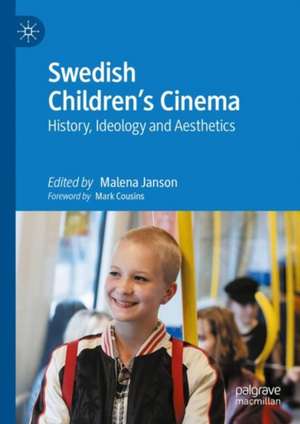Swedish Children’s Cinema: History, Ideology and Aesthetics
Editat de Malena Jansonen Limba Engleză Hardback – 9 sep 2024
Preț: 948.61 lei
Preț vechi: 1156.84 lei
-18% Nou
Puncte Express: 1423
Preț estimativ în valută:
181.53€ • 188.45$ • 151.37£
181.53€ • 188.45$ • 151.37£
Carte tipărită la comandă
Livrare economică 22 martie-05 aprilie
Preluare comenzi: 021 569.72.76
Specificații
ISBN-13: 9783031570001
ISBN-10: 3031570006
Ilustrații: IX, 264 p. 30 illus. in color.
Dimensiuni: 148 x 210 mm
Greutate: 0.54 kg
Ediția:2024
Editura: Springer Nature Switzerland
Colecția Palgrave Macmillan
Locul publicării:Cham, Switzerland
ISBN-10: 3031570006
Ilustrații: IX, 264 p. 30 illus. in color.
Dimensiuni: 148 x 210 mm
Greutate: 0.54 kg
Ediția:2024
Editura: Springer Nature Switzerland
Colecția Palgrave Macmillan
Locul publicării:Cham, Switzerland
Cuprins
Chapter 1-Introduction: On the history, ideology, and aesthetics of Swedish children’s cinema.- Part I: Histories Of a Nation.- Chapter 2. ‘D’ya know where they’re from?’: Migrants in Swedish children’s film.- Chapter 3. Beauties and beasts: On the child-nature relationship in Swedish children’s film. -Chapter 4. Like other kids, yet different: Sámi children in Swedish children’s film.- Chapter 5. Beyond subjugation and stereotype: The representation of girls in Comedy Queen.- Part II: Ideologies of Childhoods.- Chapter 6. The prankster, the funster, and the overhelper: The comedy of mischief in the Swedish folkhem.- Chapter 7. Foolish fathers in Swedish family film: Involved fatherhood and middle-class masculinity as spectacle.- Chapter 8. A relationship revolution: Child-centred parenthood in contemporary children’s cinema.- Chapter 9. ‘The movie ended quite well, but not that well, and I liked that because that’s how it is in reality’: Reception of and debates on Suzanne Osten’s films for children.- Chapter 10. We’ll never be those kids again: Queer perspectives on children’s cinema.- Part III: Aesthetics And Methods of Children’s Cinema.- Chapter 11. Audiovisual empathy: Adopting a child’s perspective in children’s cinema.- Chapter 12. Astrid Lindgren’s early filmmaking: Transmediations across radio, books, and moving images.- Chapter 13. Per Åhlin: The master of Swedish animation.- Chapter 14. Freedom captured: Film adaptations of Maria Gripe’s children’s books.- Chapter 15. ‘We just don’t know!’: A metamodal method for learning through film.
Notă biografică
Malena Janson is a senior lecturer in child culture at Stockholm University. Her research comprises the ideology and aesthetics of children’s cinema, representations of children in audiovisual media, and film education. She has also published extensively on the subjects of film and child culture in national Swedish newspapers and journals.
Textul de pe ultima copertă
Swedish children’s cinema has a long and rich history. It encompasses the rascal films of the 1920s, the realism of the 1940s, the ambitious artistic renewal of the 1970s, the child empowering films of the 1990s through the early 2000s, and the multiple, exceedingly popular, Astrid Lindgren adaptations across the decades. Devoted to exploring this cinematographic legacy, this book offers close readings across academic disciplines, probing various genres, eras, media debates, transmediations, and audience-receptions. Childhood studies, with its critical comprehension of society’s changing notions of childhood, here serves as a key framework in fruitful combination with, inter alia, feminist, queer, intermedial, postcolonial, and eco-critical perspectives. This collection fills an important knowledge gap on Swedish film history as well as the distinctly Nordic tradition of children’s culture, and thereby contributes to the burgeoning field of international children’s cinema research. It is introduced with a foreword by Mark Cousins.
Malena Janson is a senior lecturer in child culture at Stockholm University. Her research comprises the ideology and aesthetics of children’s cinema, representations of children in audiovisual media, and film education. She has also published extensively on the subjects of film and child culture in national Swedish newspapers and journals.
Malena Janson is a senior lecturer in child culture at Stockholm University. Her research comprises the ideology and aesthetics of children’s cinema, representations of children in audiovisual media, and film education. She has also published extensively on the subjects of film and child culture in national Swedish newspapers and journals.
Caracteristici
Provides extensive and versatile knowledge on the surprisingly unexplored subject of Swedish children’s cinema Features contributions from renowned child culture scholars alongside up-andcoming researchers Covers a broad range of approaches, including historic, ideological, and aesthetic
